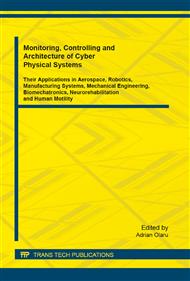[1]
Gleicher, M., Retargetting motion to new characters. In SIGGRAPH '98: Proceedings of the 25th annual conference on Computer graphics and interactive techniques. ACM, New York, NY, USA, 1998, 33–42.
DOI: 10.1145/280814.280820
Google Scholar
[2]
Liegeois, A., Automatic supervisory control of the configuration and behavior of multibody mechanisms, IEEE Transactions on Systems, Man and Cybernetics 7, 12 (Dec. ), 1977, 868 –871.
DOI: 10.1109/tsmc.1977.4309644
Google Scholar
[3]
Maciejewski, A. A. and Klein, C. A., Obstacle Avoidance for Kinematically Redundant Manipulators in Dynamically Varying Environments, The International Journal of Robotics Research 4, 3, 1998, 109–117.
DOI: 10.1177/027836498500400308
Google Scholar
[4]
Nakamura, Y., Advanced Robotics: Redundancy and Optimization. Addison-Wesley Longman Publishing, Boston, (1991).
Google Scholar
[5]
Nakamura, Y. and Hanafusa, H., Inverse kinematics solutions with singularity robustness for robot manipulator control. Journal of Dynamic Systems, Measurement, and Control. 108, 3, 1986, 163–171.
DOI: 10.1115/1.3143764
Google Scholar
[6]
Siciliano, B. and Slotine, J., A general framework for managing multiple tasks in highly redundant robotic systems, Proceedings of the IEEE International Conference on Advanced Robotics, 1991, 1211–1216.
DOI: 10.1109/icar.1991.240390
Google Scholar
[7]
Baerlocher P., Boulic, R., An Inverse Kinematic Architecture Enforcing an Arbitrary Number of Strict Priority Levels, The Visual Computer, (2003).
DOI: 10.1007/s00371-004-0244-4
Google Scholar
[8]
Zhao, L, Badler,N. Inverse Kinematics Positioning Using Nonlinear Programming for Highly Articulated Figures, ACM Transactions on Graphics, (1994).
DOI: 10.1145/195826.195827
Google Scholar
[9]
Wampler, II, C. W., Manipulator inverse kinematic solutions based on vector formulations and damped least-squares methods, IEEE Trans. Syst. Man Cybern. 16, 1, 1986, 93–101.
DOI: 10.1109/tsmc.1986.289285
Google Scholar
[10]
Kaneko, K., Kanehiro, F., Kajita, S., Yokoyama, K., Akachi, K., Kawasaki, T., Ota, S., and Isozumi, T., Design of Prototype Humanoid Robotics Platform for HRP, Proceedings IEEE/RSJ Intl. Conference on Intelligent Robots and Systems, EPFL, Lausanne, Switzerland, (2002).
DOI: 10.1109/irds.2002.1041632
Google Scholar
[11]
Montecillo,J., Human Motion Transfer on Humanoid Robot, Ph.D. Thesys, INP Toulouse, France, (2010).
Google Scholar
[12]
Olaru, A, Olaru, S. and Mihai, N., Proper Assisted Research Method Solving of the Robots Inverse Kinematics Problem, Applied Mechanics and Materials, vol. 555, 2014, 135-147.
DOI: 10.4028/www.scientific.net/amm.555.135
Google Scholar
[13]
Malinowski, T., Mikolajczyk T. and Olaru, A., Control of articulated manipulator model using ATMEGA16. Applied Mechanics and Materials, vol. 555, 2014, 147-155.
DOI: 10.4028/www.scientific.net/amm.555.147
Google Scholar


